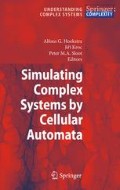Abstract
Biological organisms are complex systems characterized by collective behavior emerging out of the interaction of a large number of components (molecules and cells). In complex systems, even if the basic and local interactions are perfectly known, it is possible that the global (collective) behavior obeys new laws that are not obviously extrapolated from the individual properties. Only an understanding of the dynamics of collective effects at the molecular, and cellular scale allows answers to biological key questions such as: what enables ensembles of molecules to organize themselves into cells? How do ensembles of cells create tissues and whole organisms? Key to solving these problems is the design and analysis of appropriate mathematical models for spatio-temporal pattern formation.
Access this chapter
Tax calculation will be finalised at checkout
Purchases are for personal use only
Preview
Unable to display preview. Download preview PDF.
References
F.J. Alexander, I.Edrei, P.L. Garrido, J.L. Lebowitz, Phase transitions in a probabilistic cellular automaton: growth kinetics and critical properties. J. Statist. Phys. 68(3/4), 497–514, (1992)
A.R. Anderson, A.M. Weaver, P.T. Cummings, V. Quaranta, Tumor morphology and phenotypic evolution driven by selective pressure from the microenvironment. Cell 127(5), 905–915, (2006)
D. Basanta, H. Hatzikirou, A. Deutsch, The emergence of invasiveness in tumours: A game theoretic approach. Eur. Phys. J. B 63, 393–397, (2008)
D. Basanta, M. Simon, H. Hatzikirou, A. Deutsch, An evolutionary game theory perspective elucidates the role of glycolysis in tumour invasion. Cell Prolif. 41, 980–987, (2008)
R.D. Benguria, M.C. Depassier, V. Mendez, Propagation of fronts of a reaction-convection-diffusion equation. Phys. Rev. E 69, 031106, (2004)
D. Bray, Cell Movements (Garland Publishing, New York, 1992)
H.P. Breuer, W. Huber, F. Petruccione, Fluctuation effects on wave propagation in a reaction-diffusion process. Phys. D 73, 259, (1994)
A. Bru, S. Albertos, J.L. Subiza, J. Lopez Garcia-Asenjo, I. Bru, The universal dynamics of tumor growth. Bioph. J. 85, 2948–2961, (2003)
I. Brunet, B. Derrida Shift in the velocity of a front due to a cutoff. Phys. Rev. E 56(3), 2597–2604, (1997)
I. Brunet, B. Derrida Effect of microscopic noise in front propagation. J. Stat. Phys. 103(1/2), 269–282, (2001)
H. Bussemaker, Analysis of a pattern forming lattice gas automaton: Mean field theory and beyond. Phys. Rev. E 53(4), 1644–1661, (1996)
S.B. Carter, Principles of cell motility: the direction of cell movement and cancer invasion. Nature 208(5016), 1183–1187, (1965)
B. Chopard, M. Droz, Cellular Automata Modeling of Physical Systems (Cambridge University Press, Cambridge, 1998)
E. Cohen, D. Kessler, H. Levine, Fluctuation-regularized front propagation dynamics in reaction-diffusion systems. Phys. Rev. Lett. 94, 158302, (2005)
A. Deutsch, S. Dormann, Cellular Automaton Modeling of Biological Pattern Formation (Birkhäuser, Basel 2005)
R.B. Dickinson, R.T. Tranquillo, A stochastic model for cell random motility and haptotaxis based on adhesion receptor fuctuations. J. Math. Biol. 31, 563–600, (1993).
G.D. Doolen, Lattice Gas Methods for Partial Differential Equations (Addison-Wesley, New York, 1990)
D. Drasdo, S. Höhme, Individual-based approaches to birth and death in avascular tumors. Math. Comp. Model. 37, 1163–1175, (2003)
P. Friedl, Prespecification and plasticity: shifting mechanisms of cell migration. Curr. Opin. Cell. Biol. 16(1), 14–23, (2004)
U. Frisch, D. d’Humieres, B. Hasslacher, P. Lallemand, Y. Pomeau, J.P. Rivet, Lattice gas hydrodynamics in two and three dimensions. Compl. Syst. 1, 649–707, (1987)
H. Hatzikirou, L. Brusch, C. Schaller, M. Simon, A. Deutsch, Prediction of traveling front behavior in a lattice-gas cellular automaton model for tumor invasion. Comput. Math. Appl. 59, 2326–2339, (2010)
H. Hatzikirou, A. Deutsch, Cellular automata as microscopic models of cell migration in heterogeneous environments. Curr. Top. Dev. Biol. 81, 401–434, (2008)
A. Lesne, Discrete vs continuous controversy in physics. Math. Struct. Comp. Sc. 17(2), 185–223, (2007)
J.B. McCarthy, L.T. Furcht, Laminin and fibronectin promote the haptotactic migration of b16 mouse melanoma cells. J. Cell Biol. 98(4), 1474–1480, (1984)
H. Meinhardt, Models of Biological Pattern Formation (Academic New York, 1982)
J. Murray, Mathematical Biology I: An Introduction (Springer, Heidelberg 2001)
S.P. Palecek, J.C. Loftus, M.H. Ginsberg, D.A. Lauffenburger, A. F. Horwitz, Integrin-ligand binding governs cell-substratum adhesiveness. Nature 388(6638), 210, (1997)
D.H. Rothman, S. Zaleski, Lattice-gas models of phase separation: interfaces, phase transitions, and multiphase flow. Rev. Mod. Phys. 66(4), 1417–1479, (1994)
M. Saxton, Anomalous diffusion due to obstacles: a Monte Carlo study. Biophys. J. 66, 394–401, (1994)
M.V. Velikanov, R. Kapral, Fluctuation effects on quadratic autocatalysis fronts. J. Chem. Phys. 110, 109–115, (1999)
J. von Neumann, Theory of Self-Reproducing Automata (University of Illinois Press, Urbana, IL, 1966)
D.A. Wolf-Gladrow, Lattice-gas Cellular Automata and Lattice Boltzmann Models: An Introduction (Springer, Heidelberg 2005)
S. Wolfram, A New Kind of Science (Wolfram Media, Inc., Champaign, IL 2002)
M.H. Zaman, P. Matsudaira, D.A. Lauffenburger, Understanding effects of matrix protease and matrix organization on directional persistence and translational speed in three-dimensional cell migration. Ann. Biomed. Eng. 35(1), 91–100, (2006)
Author information
Authors and Affiliations
Corresponding author
Editor information
Editors and Affiliations
Rights and permissions
Copyright information
© 2010 Springer-Verlag Berlin Heidelberg
About this chapter
Cite this chapter
Hatzikirou, H., Deutsch, A. (2010). Lattice-Gas Cellular Automaton Modeling of Emergent Behavior in Interacting Cell Populations. In: Kroc, J., Sloot, P., Hoekstra, A. (eds) Simulating Complex Systems by Cellular Automata. Understanding Complex Systems. Springer, Berlin, Heidelberg. https://doi.org/10.1007/978-3-642-12203-3_13
Download citation
DOI: https://doi.org/10.1007/978-3-642-12203-3_13
Published:
Publisher Name: Springer, Berlin, Heidelberg
Print ISBN: 978-3-642-12202-6
Online ISBN: 978-3-642-12203-3
eBook Packages: Physics and AstronomyPhysics and Astronomy (R0)

